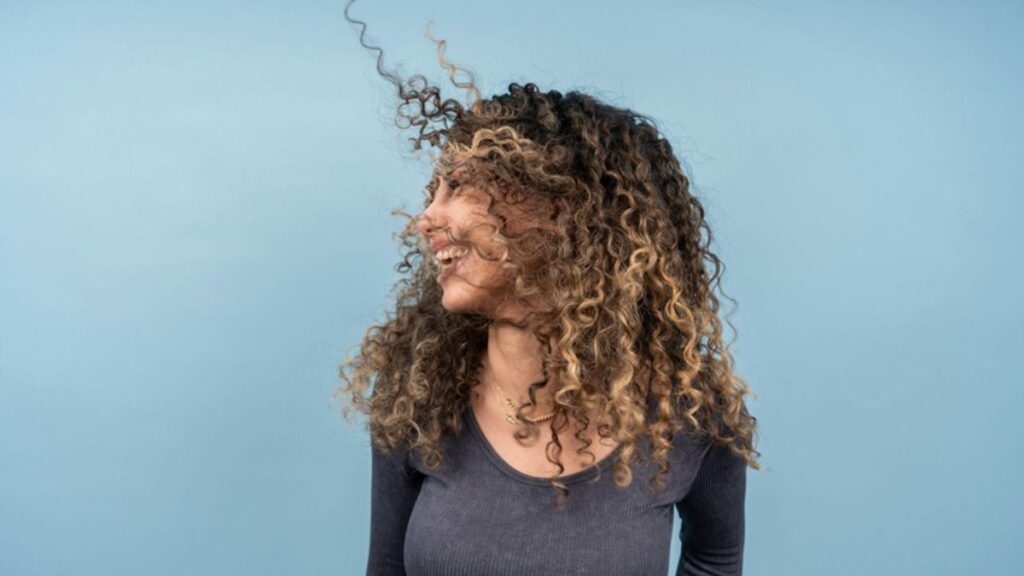- Healthy curls thrive on moisture, but not all products deliver it effectively
- Recognizing your hair’s texture, porosity, and curl pattern is key to choosing the right routine
- Simplifying your routine and avoiding common curl-damaging habits can make a huge difference
- Listening to your hair’s changing needs is more powerful than copying someone else’s regimen
Curls can be a mystery. One day they’re springy, shiny, and full of life—another day, they’re dry, limp, and frizzed beyond recognition. If you’ve ever felt like your curls have a mind of their own, you’re not alone. Curly hair operates on its own set of rules, and figuring out what it needs (and what it definitely doesn’t) is half the battle.
That avalanche of product advice on social media? It’s often more confusing than helpful. Because what works for one curly head can flop on another. This blog is here to cut through the noise. You’ll learn the essentials that support healthy, defined curls—and the unnecessary extras that might drag them down.
Ready to decode what your curls are asking for? Let’s dive in.
Understanding What Your Curls Are Telling You
Your curls aren’t just wild or unpredictable—they’re expressive. They communicate with you every wash day, and tuning into their signals can transform your routine. Before grabbing another product or following another influencer’s advice, it helps to know what you’re working with.
First, consider curl patterns—whether you have loose waves, defined ringlets, or tight coils. But just knowing your pattern isn’t enough. Porosity (your hair’s ability to absorb and hold moisture) often matters more. High-porosity hair might feel dry even after conditioning, while low-porosity hair can feel product-heavy in seconds.
Then there’s texture—how fine or coarse each strand is. Fine hair might be weighed down by creamy stylers, while thicker strands often crave rich, emollient formulas.
The real magic happens when you combine all this info. High-porosity coils need different care than low-porosity waves, even if they look curly. If your curls are dry, breaking easily, or losing definition quickly, that’s your hair’s way of saying, “Hey, something’s off.” But when curls clump together effortlessly, bounce back when stretched, and feel soft to the touch? You’re on the right track.
Learning to read these cues is way more powerful than copying someone else’s product list. Because once you know what your curls are asking for, you can give them exactly that—no more, no less.
Products That Work With Curls, Not Against Them
A million products are marketed to curly hair, but very few help your curls thrive. The key? Choosing formulas that work with your hair’s natural texture instead of smothering or stripping it.
Moisture is everything when it comes to curls. But not all moisture-rich products are created equal. Some heavy creams and oils promise hydration but sit on the surface, creating buildup and blocking your strands from absorbing what they need. Others are loaded with drying alcohols or hidden silicones, leaving hair looking shiny but feeling straw-like.
One game-changer in many curl routines is using a nourishing leave in conditioner for curly hair. The right formula can provide long-lasting hydration, help lock in moisture after your wash routine, and offer some light definition without the crunch. Think of it as the bridge between your wash and styling steps—it sets the stage for everything else.
But here’s where many people go wrong: slathering on too much, too often. Even the best leave-in can backfire if it’s layered without purpose. If your curls start feeling sticky, limp, or greasy after day one, it might be a sign your product is overdoing it. Try using less, or adjusting when and how you apply it (for example, damp vs. soaking wet hair can make a big difference).
It’s also worth paying attention to what else is in your lineup. If your gel, cream, and leave-in all do the same thing, your hair could be getting overwhelmed. Streamlining your product routine can help each item do its job better and make your curls easier to manage.
The Don’ts That Drag Down Your Curl Game
Let’s be real—some things labeled “curl-friendly” are anything but. The curly hair aisle is packed with well-meaning products and advice, but some of the most common habits and ingredients can quietly ruin your curl health over time.
First up: sulfates and harsh detergents. These strip the natural oils your curls desperately need. While they might give you that squeaky-clean feeling, they’re drying out your hair and leaving your curls brittle and vulnerable. Swap those out for gentler cleansers; your curls will thank you in softness and bounce.
Then there’s the sneaky world of heavy silicones. Sure, they add instant shine and slip, but they build up and block moisture from getting in over time. Silicone buildup could be the silent culprit if your curls feel smooth but still look flat or undefined. Clarifying occasionally is helpful, but using products that don’t clog your strands in the first place is even better.
Another common mistake? Overloading on products or layering them with no strategy. More gel, mousse, and oil might seem like the path to definition, but it often leads to weighed-down, greasy hair that loses shape by day two. It’s tempting to keep adding steps, especially when you’re chasing that perfect curl day, but often, less is more.
The most overlooked issue is copycat routines. It’s normal to want to replicate someone else’s results, especially when they have amazing curls. But blindly following someone’s regimen without understanding your hair type, porosity, and texture can lead to severe frustration. What works for a type 3a low-porosity curl won’t necessarily work for a type 4b high-porosity coil.
The takeaway here? Healthy curls aren’t just about what you do but also about what you stop doing. Eliminating the wrong stuff can be as powerful as finding the right products.
A Simpler, Smarter Curl Routine
If you’ve ever felt overwhelmed trying to “fix” your curls, it might be time to shift your approach. A good curl routine isn’t about using a dozen miracle products—it’s about listening to your hair and giving it what it needs without overcomplicating things.
Start with the basics: cleanse, condition, hydrate, and style. That’s it. Once you understand how each step affects your curls, you can fine-tune without the pressure of following a 10-step routine.
For instance, your hair thrives when you deep condition it every two weeks instead of weekly. Or maybe your curls love a lightweight gel on top of a simple leave-in rather than a cocktail of five stylers. It’s all about small experiments and adjusting as you go, not rigid rules.
The order in which you apply products also matters more than you might think. Applying a leave-in before styling products helps lock in moisture and creates a smoother foundation. Some people swear by layering from lightest to heaviest, while others flip the script depending on their hair’s needs that day. There’s no correct answer—just what works for your curls.
And remember: your hair’s needs can change. Weather, water quality, and even hormones can shift what your curls crave. So stay flexible. That “holy grail” product might work wonders in winter but feel heavy in humid summer.
Ultimately, the goal isn’t perfect curls—happy, healthy curls that feel like you. Building a simpler, smarter routine helps cut through the noise and makes wash day less chore and more of a celebration.
Conclusion: Listening to Your Hair is the Real Secret
Curls don’t come with a one-size-fits-all manual—and that’s their beauty. Your hair constantly gives you feedback, whether responding to moisture, resisting buildup, or begging for a break from product overload. The trick isn’t in chasing trends or mimicking routines. It’s in tuning in to what your curls are asking for and responding with care, not panic.
You don’t need a shelf full of products or a three-hour wash day. You just need to build habits that support your curls’ health, stay flexible as their needs change, and keep it simple. With attention and consistency, your curls will reward you in bounce, softness, and that effortless look we all love.
Let go of perfection, trust your instincts, and let your curls be their beautifully imperfect selves.
Should you wish to explore other topics, head to our main blog. We’ve got more!







